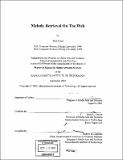| dc.contributor.advisor | Barry L. Vercoe. | en_US |
| dc.contributor.author | Chai, Wei, 1972- | en_US |
| dc.contributor.other | Massachusetts Institute of Technology. Dept. of Architecture. Program In Media Arts and Sciences. | en_US |
| dc.date.accessioned | 2011-02-23T14:16:03Z | |
| dc.date.available | 2011-02-23T14:16:03Z | |
| dc.date.copyright | 2001 | en_US |
| dc.date.issued | 2001 | en_US |
| dc.identifier.uri | http://hdl.handle.net/1721.1/61120 | |
| dc.description | Thesis (S.M.)--Massachusetts Institute of Technology, School of Architecture and Planning, Program in Media Arts and Sciences, 2001. | en_US |
| dc.description | Includes bibliographical references (p. 87-90). | en_US |
| dc.description.abstract | The emergence of digital music on the Internet requires new information retrieval methods adapted to specific characteristics and needs. While music retrieval based on the text information, such as title, composers, or subject classification, has been implemented in many existing systems, retrieval of a piece of music based on musical content, especially an incomplete, imperfect recall of a fragment of the music, has not yet been fully explored. This thesis will explore both theoretical and practical issues involved in a web-based melody retrieval system. I built a query-by-humming system, which can find a piece of music in the digital music repository based on a few hummed notes. Since an input query (hummed melody) may have various errors due to uncertainty of the user's memory or the user's singing ability, the system should be able to tolerate errors. Furthermore, extracting melodies to build a melody database is also a complicated task. Therefore, melody representation, query construction, melody matching and melody extraction are critical for an efficient and robust query-by-humming system. Thus, these are the main tasks to be addressed in the thesis. Compared to previous systems, a new and more effective melody representation and corresponding matching methods which combined both pitch and rhythmic information were adopted, a whole set of tools and deliverable software were implemented, and experiments were conducted to evaluate the system performance as well as to explore other melody perception issues. Experimental results demonstrate that our methods incorporating rhythmic information rather than previous pitch-only methods did help improving the effectiveness of a query-by-humming system. | en_US |
| dc.description.statementofresponsibility | by Wei Chai. | en_US |
| dc.format.extent | 90 p. | en_US |
| dc.language.iso | eng | en_US |
| dc.publisher | Massachusetts Institute of Technology | en_US |
| dc.rights | M.I.T. theses are protected by
copyright. They may be viewed from this source for any purpose, but
reproduction or distribution in any format is prohibited without written
permission. See provided URL for inquiries about permission. | en_US |
| dc.rights.uri | http://dspace.mit.edu/handle/1721.1/7582 | en_US |
| dc.subject | Architecture. Program In Media Arts and Sciences. | en_US |
| dc.title | Melody retrieval on the Web | en_US |
| dc.type | Thesis | en_US |
| dc.description.degree | S.M. | en_US |
| dc.contributor.department | Program in Media Arts and Sciences (Massachusetts Institute of Technology) | |
| dc.identifier.oclc | 50396995 | en_US |

